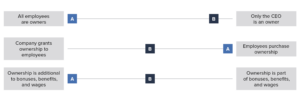Long-term companies invest in their employees.
In The People Factor: How Investing in Employees Pays Off, FCLTGlobal found that over a three-year period, committed employers – companies that back up talk about investing in employees with action – are associated with a four percent higher return on invested capital (ROIC) on an absolute basis than counterparts that did neither. Even over the short term (within one year), companies that are committed employers are associated with better outcomes than companies that neither communicate nor demonstrate commitments to invest in employees:
- 2 percent higher contemporaneous annual ROIC on an absolute basis,
- 5 percent higher contemporaneous annual sales growth on an absolute basis,
- 8 percent lower annual employee turnover on an absolute basis.
There are many ways to invest in employees, including increasing wages, enhancing benefits, offering company shares, and improving the workplace (DEI, training opportunities). Each method has pros and cons to consider.

- In Walking the Talk: Valuing a Multi-Stakeholder Strategy, FCLTGlobal identified key stakeholder groups such as employees, suppliers, communities, and governments and showed that companies that paired strong stakeholder language with strong performance on material ESG measures outperformed peers in the long run.
- In The People Factor: How Investing in Employees Pays Off, FCLTGlobal dove deeper into a specific stakeholder group – employees – and showed that companies that invest in their workforce (whether through wages, benefits, ownership, and diversity) outperform in the long run.
- This article aims to expand on one of the many ways companies can invest in their employees – through employee ownership.
Building on the momentum set by FCLTGlobal’s research on stakeholder capitalism and investing in employees , The Long-term Payoff of Employee Ownership aims to dive deeper into one of the many ways employers can invest in their workforce.
Employee ownership yields several benefits including employee retention, enhanced engagement, and fostering an ownership mindset.
Evidence indicates that when employees have a stake in the company, turnover decreases. For example, a study sponsored by the UK Treasury analyzed data from company tax records on tax-advantaged share schemes at over 16,000 firms in the UK and found that broad-based ownership was linked to improved turnover.
Likewise, a 2015 study of employee ownership in the 100 best companies to work for in America found that employee ownership coupled with empowering labor policies reduced voluntary turnover as employees had greater incentive to stay. The same 2015 study found that this created a more positive workplace culture with improved information sharing, employee participation in decision-making, and trust in supervisors.
Cultivating an “ownership mindset” by providing employees with share ownership opportunities can boost a company’s performance in various areas.
For example, employees are more likely to exhibit behaviors indicative of an ownership mindset when they are invested in company outcomes. A study involving over 40,000 workers revealed that those who had company stock and other group incentives were more inclined to intervene if they observed a colleague’s performance declining. They expressed readiness to address the issue by speaking directly to underperforming colleagues, their supervisor, or fellow team members.
Defining employee ownership
Employee ownership, or programs through which employees have a financial stake in the company, is gaining recognition for its potential to boost performance and enhance employees’ financial outcomes. Such programs can include stock grants, stock options, stock purchasing plans, employee stock ownership plans (ESOPs), and restricted stock unit grants.
Employee ownership is a well-established concept in global public markets
- In 2020, 49 percent of S&P 500 companies and 38 percent of Russell 3000 companies offered an employee stock purchasing plan to their employees.
- In Europe, the percentage of companies offering broad-based plans increased from 33 percent in 2006 to 53 percent in 2020, but the share of the workforce participating in plans declined from 23 percent in to 18.5 percent in the same period.
- In Japan, employee stock option plans are widespread: A 2022 survey of Tokyo Stock Exchange companies found that roughly 80 percent of companies offer stock option plans. However, the same survey found that only 37 percent of the total employee population participated in stock option plans.
Broad-based, granted, and additional employee ownership is much less common, with only a handful of companies in public markets granting shares to all employees regardless of title or performance. Due to this constraint, studies on employee ownership cover multiple types of ownership programs including employee stock purchasing plans, stock options, stock as a part of bonuses, and restricted stock units.
Ownership Works is a chief advocate of broad-based, additional employee ownership at US-based private equity backed companies. Since the organization’s founding, they have made significant progress, including 88 companies with board-approved shared ownership plans, impacting 111,658 employees, sharing $395,340,473 in actual wealth to date, and generating $130,124,440 in impact for low- and moderate-income workers. While the efforts of Ownership Works have been mainly focused on US privately backed firms, here we explore the long-term value creation potential of employee ownership at publicly listed companies.
Employee ownership: broad-based, granted, and additional
Broad-based employee ownership is defined as having company equity granted to all employees, rather than limited to board directors and executive teams (“broad-based”), and provided in addition to competitive wages, performance-based bonuses, or benefits. However, there are many ways to offer ownership to employees, and choices can be considered in a spectrum. Take for example the following illustrative companies:
- Company A provides ownership opportunities to all employees regardless of title or performance metrics, and employees must purchase shares with their earnings at full price.
- Company B provides ownership to C-suite employees, in the form of performance-based share grants (bonus) and stock purchase plans (regardless of performance) at a discounted price.

Short-term concerns about broad-based ownership underscore the need for a long-term focus.
Share dilution is a common concern for shareholders considering an employee ownership plan. Issuing new shares to employees reduces the ownership percentage of existing shareholders and can impact earnings per share, ownership concentration, and voting power in the short run. This could lead to a “no” vote from shareholders on ballot initiatives to implement broader employee ownership.
Some companies avoid dilution by only offering shares to a select group of employees, usually executives and senior employees. However, this approach may not achieve the same long-term benefits as fostering an ownership mindset throughout the entire organization.
“…companies that reserve equity compensation for executives and leave the rest of the workforce out of ownership plans are bound to suffer in the long run. Top managers aren’t the only ones who make a difference to a business. Study after study proves that broad-based ownership, when done right, leads to higher productivity, lower workforce turnover, better recruits, and bigger profits.”
Rosen, et al. Every Employee an Owner, Really. (2005, June). Harvard Business Review
The long-term benefits of fostering an ownership mindset may outweigh the short-term impact of dilution.
Companies that implement broad-based employee ownership may experience a J-curve effect over the long run. For example, a company may experience a short-term dip in share price when a program is first established but reap the well-researched long-term benefits of an ownership culture, such as improved retention, better employee engagement, greater stability, and better performance, potentially outweighing upfront costs.
The challenge lies in isolating causal evidence of the J-curve hypothesis. Rutgers University’s Douglas Kruse, a prominent scholar in the field of employee ownership, notes that isolating the causal effects of employee ownership is incredibly challenging, especially when combined with other beneficial practices like decision-making participation and information sharing. Although pre/post studies and limited experimental evidence suggest a causal impact, the absence of field experiments with random assignment hinders definitive conclusions.
The conversation around broad-based employee ownership has focused on private markets for a reason. Private company owners have more control over the decision-making process. They can tailor employee ownership plans to fit the specific needs and goals of the company without needing approval from public shareholders who may not fully appreciate the long-term benefits of the program. Publicly listed companies are under much more scrutiny, with greater regulatory requirements. Implementing a broad-based ownership plan would require a long-term focus from leaders, board members, and large shareholders, along with a strong business case.
Evidence shows that employee ownership has the potential to improve company financial performance in the long run.
Evidence from public and private markets coupled with examples from leading companies show that employee ownership improves financial performance and boosts survival rates during economic downturns.
A global 2016 meta-analysis of studies on employee ownership with a sample of 56,984 firms from around the world in both public and private markets found a small but positive and statistically significant relationship to firm performance – with employee ownership firms scoring 35 percent higher on performance than other firms.
Evidence from a different 2016 study indicates employee ownership firms also appear to have higher survival rates. Publicly traded US companies with employee ownership are about 20 percent more likely than closely matched comparable firms to overcome a recession and survive over a 12-year period.
There are publicly listed organizations that already invest in their employees through share ownership.
Starbucks’ Global Bean Stock Program
The Bean Stock program was introduced in 1991 by Howard Schultz, Starbucks’ former CEO, to involve employees in the company’s financial success. Bean Stock has been a cornerstone of Starbucks’ efforts to foster an ownership mindset among its employees, whom it refers to as “partners.” In 2022, more than 230,000 partners in 21 markets received Bean Stock, including Austria, Great Britain, Italy, Switzerland, Japan, China, Canada, and the United States.
The company provides every eligible partner with the opportunity to share in the financial success of the company through equity stock, a company match for retirement funds, and access to financial wellness programs to help manage student loan debt and save for both short-term needs and long-term planning.
Starbucks experiences tangible benefits from having an ownership culture: According to Starbucks’ annual report, in FY22, the total partner turnover in North America (U.S. and Canada) was nearly 65 percent, significantly lower than annual food and accommodation services turnover rates, which was close to 85 percent in 2022 according to the Bureau of Labor Statistics (BLS). The causation debate remains open for further investigation; there are several factors that could contribute to lower annual employee turnover at Starbucks.
Walmart’s stock grants for US-based managers
More recently, Walmart, the largest private employer in the United States, announced that US-based store managers may receive up to $20,000 in annual stock grants. The stock will vest over a three-year period, with a percentage vested each quarter.
Cedric Clark, Executive Vice President, Store Operations, Walmart U.S. exemplifies an ownership culture in a letter to store managers “…each of you is the CEO of a multimillion-dollar business… We see an investment in you as an investment in our culture, our core values and in the day-to-day experience of every associate in every store. Investing in you is an investment in our future”.
Conclusion
Although investors may worry about short-term dilution, global data from both public and private markets, along with case studies of leading companies, indicate that broad-based employee ownership can boost long-term value performance. By investing in their workforce through employee ownership programs, companies can create a sustainable advantage that benefits both employees and shareholders alike in the long term. As economic inclusivity continues to be a growing global priority, employee ownership models offer a path towards shared prosperity.





